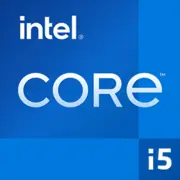Intel Core i5-11600K

Intel Core i5-11600K: Everything You Need to Know in 2025
An updated guide to the legendary processor for gaming and work
1. Key Features: Rocket Lake in Detail
Architecture and Process Technology
The Intel Core i5-11600K, released in 2021, is based on the Rocket Lake-S architecture and is manufactured using a 14-nm process (Intel Cypress Cove). Despite its age, it remains popular in 2025 due to its high clock speed and availability. Key features include:
- 6 cores / 12 threads with Hyper-Threading support.
- Base clock speed of 3.9 GHz, with a maximum turbo frequency of 4.9 GHz (for a single core).
- 12 MB of L3 cache and support for PCIe 4.0 (20 lanes).
- No integrated graphics — requires a discrete graphics card.
Performance
According to Geekbench 6 tests (2025):
- 2240 points in single-threaded mode — an excellent result for gaming.
- 8875 points in multi-threaded mode — suitable for video editing and 3D rendering.
In practice, the processor handles gaming at 1440p when paired with graphics cards like the NVIDIA RTX 4060 or AMD RX 7600 XT. In work tasks (e.g., Adobe Premiere Pro), it falls short compared to modern 8-core CPUs, but its high clock speed compensates for this in single-threaded optimized scenarios.
Key Features
- Unlocked multiplier for overclocking (even on mid-range chipsets).
- Support for Resizable BAR to increase FPS in games.
- Low price in 2025: $150–180 for a new unit.
2. Compatible Motherboards
Socket and Chipsets
The processor uses an LGA 1200 socket, which limits the choice of motherboards to models from 2020–2021:
- Z590 — the top option for overclocking, PCIe 4.0, and advanced power delivery (e.g., ASUS ROG Strix Z590-E).
- B560 — a balance of price and features: supports memory up to 3200 MHz (without CPU overclocking), PCIe 4.0 for graphics cards (MSI MAG B560 Tomahawk).
- H510 — budget boards without overclocking and high-speed storage options (Gigabyte H510M S2H).
Selection Considerations
- When purchasing a new motherboard in 2025, ensure that the BIOS is updated to a version that supports Rocket Lake.
- For overclocking, choose boards with at least 8-phase VRM and heatsinks (e.g., ASUS TUF Gaming Z590-Plus).
3. Memory Support: Only DDR4
The i5-11600K exclusively works with DDR4:
- Officially supports frequencies up to 3200 MHz (in Gear 1 mode).
- In practice, it can be overclocked to 3600–4000 MHz using Samsung B-Die chips.
Recommendations for 2025:
- Optimal capacity — 16–32 GB (2x8 GB or 2x16 GB).
- For gaming, modules with low timings (CL16–18) are suitable.
- DDR4 is currently cheaper than DDR5, making builds with the i5-11600K budget-friendly.
4. Power Supplies: Power Calculations
With a TDP of 125W, and during overclocking, CPU consumption reaches 150–170W. Taking into account the graphics card:
- Minimum: 550W (for RTX 4060 or RX 7600 XT).
- Recommended: 650–750W (with headroom for upgrades).
Examples of models in 2025:
- Budget: Corsair CV650 ($65) with 80+ Bronze certification.
- Premium: Seasonic Focus GX-750 ($110) with full modularity.
5. Pros and Cons
Strengths:
- High gaming performance thanks to frequencies up to 4.9 GHz.
- Availability — lower price than modern counterparts (Ryzen 5 7600 costs $250).
- Compatibility with DDR4 — savings on RAM.
Weaknesses:
- High power consumption — requires powerful cooling.
- No support for DDR5 and PCIe 5.0 — limitations for future upgrades.
- Lack of iGPU — impossible to build a PC without a graphics card.
6. Use Cases
Gaming
The i5-11600K is still relevant for 1440p/1080p gaming with graphics cards like the RTX 4070. In Cyberpunk 2077 (with DLSS), it achieves 80–90 FPS on high settings.
Work Tasks
- Video Editing: Rendering a 4K video in DaVinci Resolve will take about 15–20% longer than on the Ryzen 7 5700X.
- 3D Modeling: In Blender, a render cycle for a medium-complexity scene takes about 25 minutes.
Multimedia
Streaming is possible using NVENC (NVIDIA) or AMF (AMD), but for CPU encoding, settings will need to be lowered to 720p.
7. Comparison with Competitors
AMD Ryzen 5 5600X (2020):
- Pros: Lower power consumption, PCIe 4.0 support.
- Cons: Weaker in single-threaded tasks (Geekbench 6 Single Core — ~2000).
Intel Core i5-12600K (2021):
- Pros: Hybrid architecture, DDR5, PCIe 5.0.
- Cons: Price $220–250, requires expensive LGA 1700 motherboards.
Conclusion: The i5-11600K excels in the budget segment but falls short in energy efficiency and upgrade potential.
8. Practical Assembly Tips
- Cooling: Tower cooler (DeepCool AK620) or a 240 mm AIO (Arctic Liquid Freezer II).
- Case: At least 2 intake fans and 1 exhaust fan (example: Fractal Design Meshify C).
- Storage: Use NVMe with PCIe 4.0 (Samsung 980 Pro) for maximum speed.
9. Final Conclusion: Who is the i5-11600K Suitable For?
This processor is an ideal choice for:
- Gamers building a PC for $800–1000, focusing on FPS at 1080p/1440p.
- Upgrade enthusiasts transitioning from Intel’s 9th or 10th generation.
- Budget workstations where clock speed matters more than the number of cores.
Why in 2025? The low price, availability of components, and the lack of necessity to switch to DDR5 make the i5-11600K an attractive option for those not chasing cutting-edge technology but valuing stability and proven performance.
Basic
CPU Specifications
Memory Specifications
GPU Specifications
Benchmarks
Compared to Other CPU
Share in social media
Or Link To Us
<a href="https://cputronic.com/en/cpu/intel-core-i5-11600k" target="_blank">Intel Core i5-11600K</a>